Abstract
The synthesis of haem has been postulated to be a key regulatory step in muscle mitochondrial biogenesis. We examined the expression of delta-aminolaevulinate synthase (ALAs), the regulatory enzyme of haem metabolism, in 10 Hz electrically stimulated and non-stimulated control rat tibialis anterior (TA) muscle. ALAs activity and mRNA levels were measured at 0, 18 and 48 h of recovery after 3 h of acute stimulation, or after 7 days of stimulation (3 h/day). ALAs activity in control muscles averaged 7.8 +/- 0.8 nmol/h per g (n = 30). After 3 h of stimulation and during recovery, no change in ALAs activity occurred. ALAs mRNA during the same time was unchanged except at 48 h of recovery, when it increased 1.3-fold above control (P < 0.05). After 7 days of stimulation, ALAs activity was unchanged at 0 h, but increased at 18 and 48 h of recovery to 2.0- and 1.8-fold above control (P < 0.05). ALAs mRNA was also increased, but to a level averaging 1.6-fold above control (P < 0.05) at all times, indicating an increased mRNA stability or synthesis. No change in the haem-containing enzyme cytochrome c oxidase (CYTOX) activity occurred after 3 h of stimulation in the red section of the TA. After 7 days of stimulation, the increase in CYTOX activity averaged 1.7-fold above control (P < 0.05) at all times. Thus the induction of ALAs during recovery after 7 days was regulated by factors which not only change ALAs mRNA content, but which also affect ALAs mRNA at translational or post-translational steps. This induction occurred despite a 1.7-fold increase in CYTOX, implying that a precursor-product relationship does not always exist.
Full text
PDF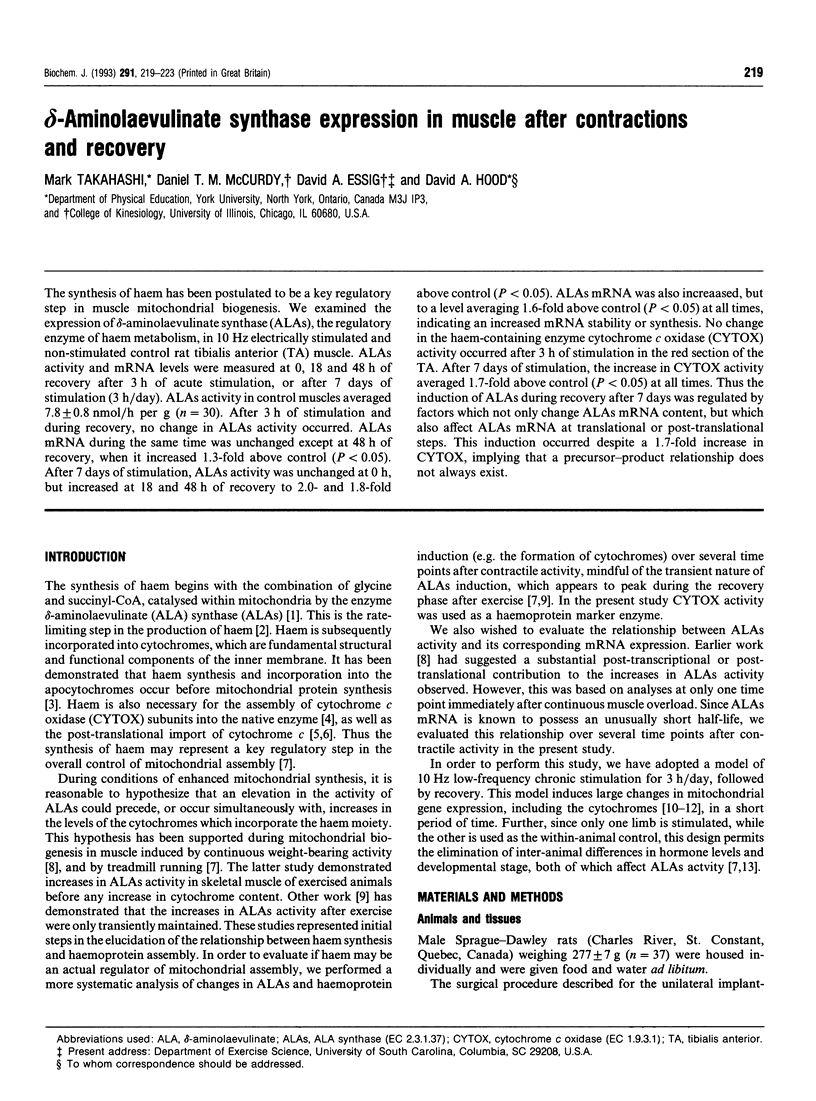
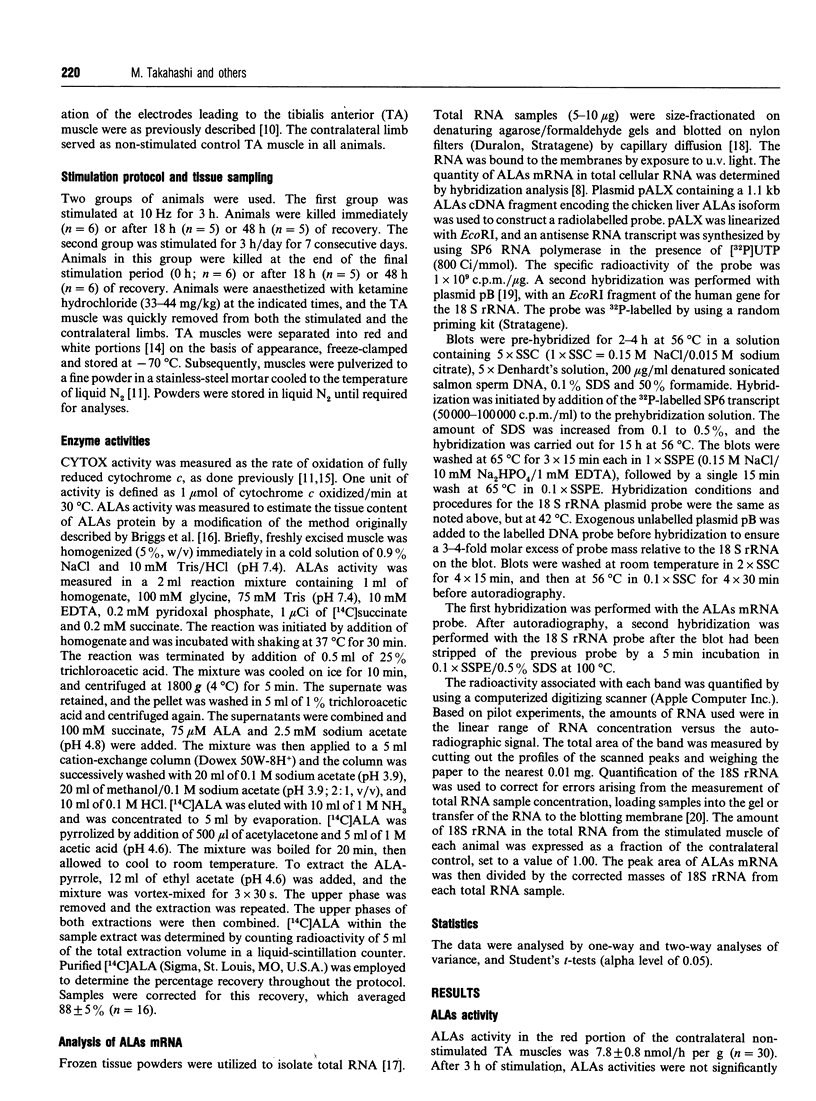
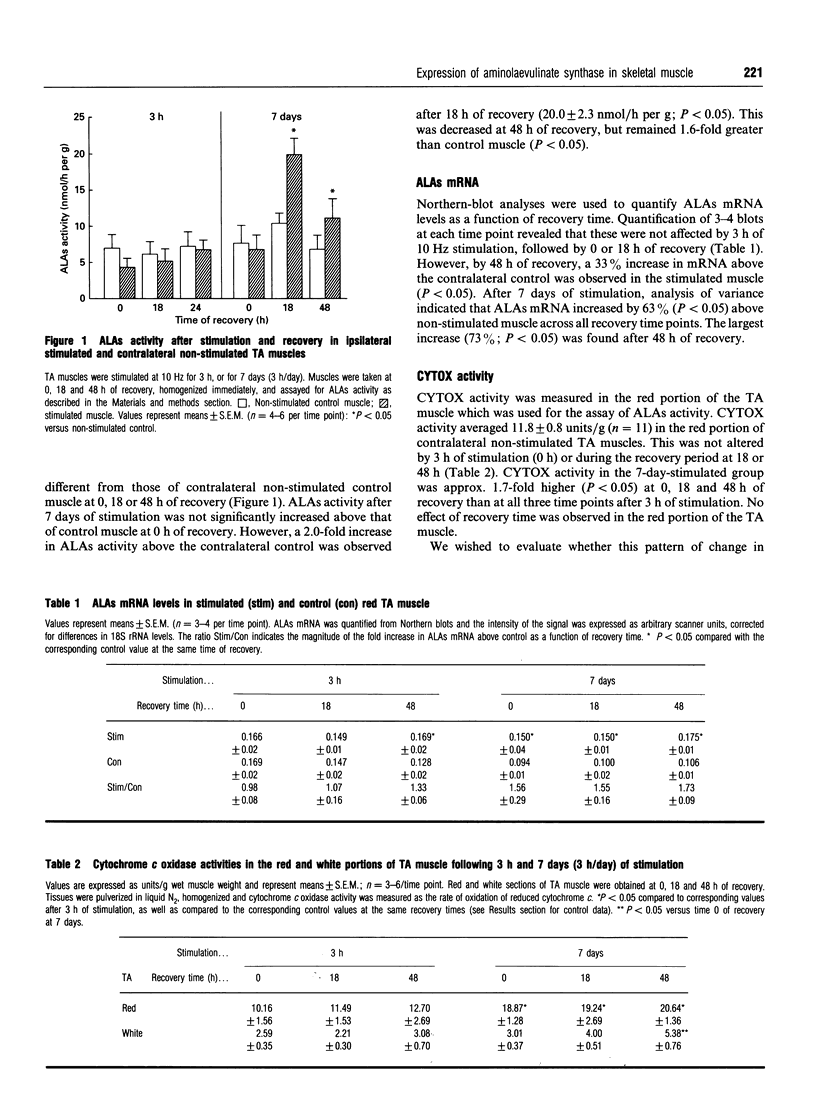
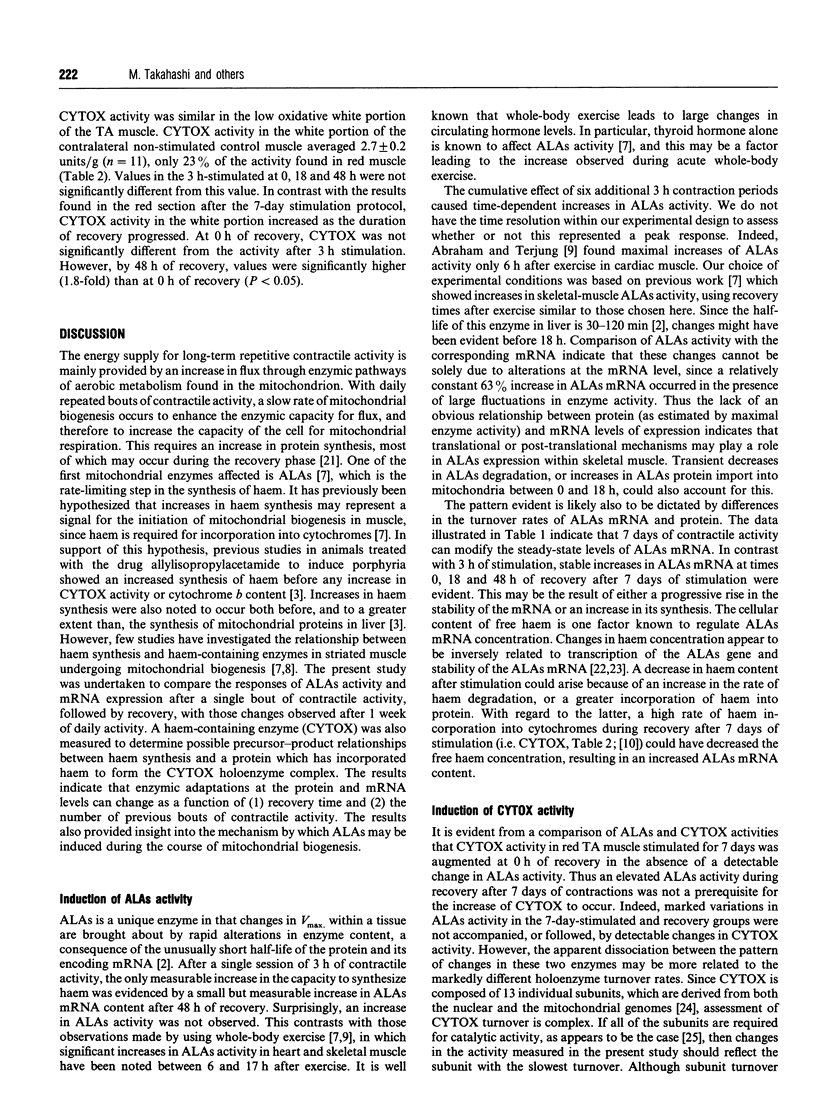
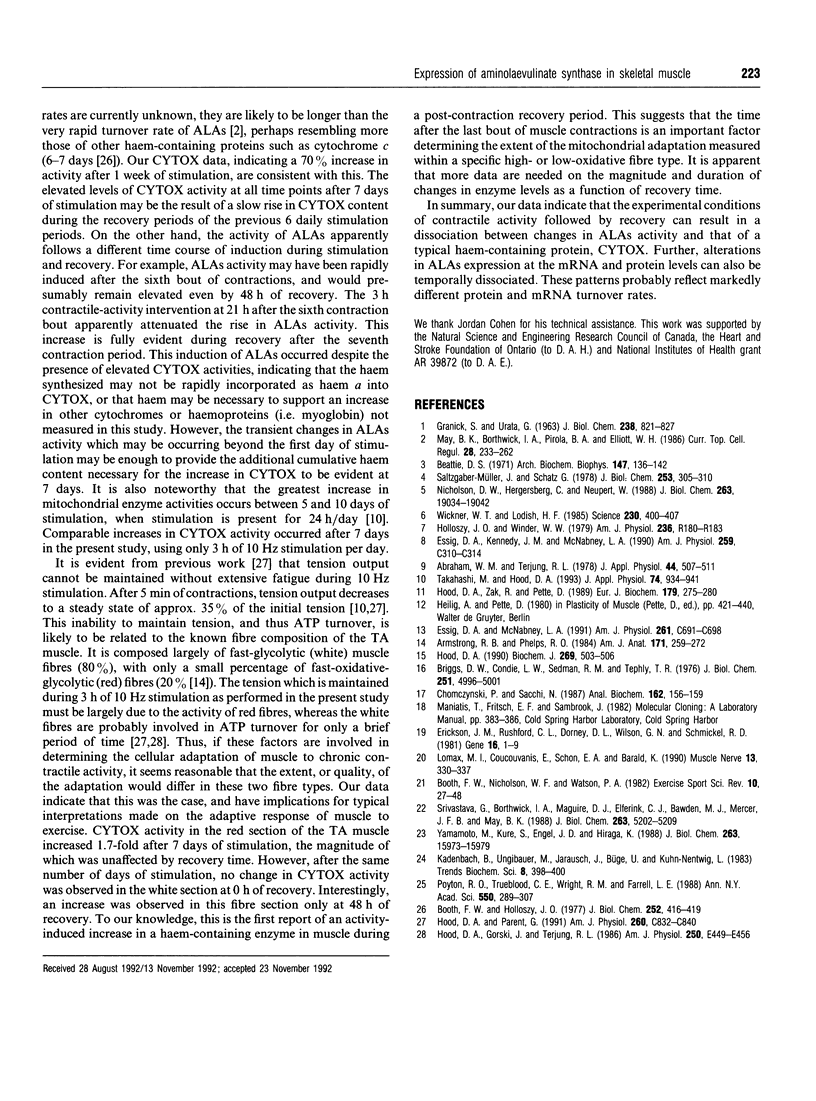
Selected References
These references are in PubMed. This may not be the complete list of references from this article.
- Abraham W. M., Terjung R. L. Increased delta-aminolevulinic acid synthetase activity in rat ventricle after acute exercise. J Appl Physiol Respir Environ Exerc Physiol. 1978 Apr;44(4):507–511. doi: 10.1152/jappl.1978.44.4.507. [DOI] [PubMed] [Google Scholar]
- Armstrong R. B., Phelps R. O. Muscle fiber type composition of the rat hindlimb. Am J Anat. 1984 Nov;171(3):259–272. doi: 10.1002/aja.1001710303. [DOI] [PubMed] [Google Scholar]
- Beattie D. S. The possible relationship between heme synthesis and mitochondrial biogenesis. Arch Biochem Biophys. 1971 Nov;147(1):136–142. doi: 10.1016/0003-9861(71)90319-5. [DOI] [PubMed] [Google Scholar]
- Booth F. W., Holloszy J. O. Cytochrome c turnover in rat skeletal muscles. J Biol Chem. 1977 Jan 25;252(2):416–419. [PubMed] [Google Scholar]
- Booth F. W., Nicholson W. F., Watson P. A. Influence of muscle use on protein synthesis and degradation. Exerc Sport Sci Rev. 1982;10:27–48. [PubMed] [Google Scholar]
- Briggs D. W., Condie L. W., Sedman R. M., Tephly T. R. Delta-Aminolevulinic acid synthetase in the heart. J Biol Chem. 1976 Aug 25;251(16):4996–5001. [PubMed] [Google Scholar]
- Chomczynski P., Sacchi N. Single-step method of RNA isolation by acid guanidinium thiocyanate-phenol-chloroform extraction. Anal Biochem. 1987 Apr;162(1):156–159. doi: 10.1006/abio.1987.9999. [DOI] [PubMed] [Google Scholar]
- Erickson J. M., Rushford C. L., Dorney D. J., Wilson G. N., Schmickel R. D. Structure and variation of human ribosomal DNA: molecular analysis of cloned fragments. Gene. 1981 Dec;16(1-3):1–9. doi: 10.1016/0378-1119(81)90055-x. [DOI] [PubMed] [Google Scholar]
- Essig D. A., Kennedy J. M., McNabney L. A. Regulation of 5'-aminolevulinate synthase activity in overloaded skeletal muscle. Am J Physiol. 1990 Aug;259(2 Pt 1):C310–C314. doi: 10.1152/ajpcell.1990.259.2.C310. [DOI] [PubMed] [Google Scholar]
- Essig D. A., McNabney L. A. Muscle-specific regulation of the heme biosynthetic enzyme 5'-aminolevulinate synthase. Am J Physiol. 1991 Oct;261(4 Pt 1):C691–C698. doi: 10.1152/ajpcell.1991.261.4.C691. [DOI] [PubMed] [Google Scholar]
- GRANICK S., URATA G. Increase in activity of alpha-aminolevulinic acid synthetase in liver mitochondria induced by feeding of 3,5-dicarbethoxy-1,4-dihydrocollidine. J Biol Chem. 1963 Feb;238:821–827. [PubMed] [Google Scholar]
- Holloszy J. O., Winder W. W. Induction of delta-aminolevulinic acid synthetase in muscle by exercise or thyroxine. Am J Physiol. 1979 Mar;236(3):R180–R183. doi: 10.1152/ajpregu.1979.236.3.R180. [DOI] [PubMed] [Google Scholar]
- Hood D. A. Co-ordinate expression of cytochrome c oxidase subunit III and VIc mRNAs in rat tissues. Biochem J. 1990 Jul 15;269(2):503–506. doi: 10.1042/bj2690503. [DOI] [PMC free article] [PubMed] [Google Scholar]
- Hood D. A., Gorski J., Terjung R. L. Oxygen cost of twitch and tetanic isometric contractions of rat skeletal muscle. Am J Physiol. 1986 Apr;250(4 Pt 1):E449–E456. doi: 10.1152/ajpendo.1986.250.4.E449. [DOI] [PubMed] [Google Scholar]
- Hood D. A., Parent G. Metabolic and contractile responses of rat fast-twitch muscle to 10-Hz stimulation. Am J Physiol. 1991 Apr;260(4 Pt 1):C832–C840. doi: 10.1152/ajpcell.1991.260.4.C832. [DOI] [PubMed] [Google Scholar]
- Hood D. A., Zak R., Pette D. Chronic stimulation of rat skeletal muscle induces coordinate increases in mitochondrial and nuclear mRNAs of cytochrome-c-oxidase subunits. Eur J Biochem. 1989 Feb 1;179(2):275–280. doi: 10.1111/j.1432-1033.1989.tb14551.x. [DOI] [PubMed] [Google Scholar]
- Lomax M. I., Coucouvanis E., Schon E. A., Barald K. F. Differential expression of nuclear genes for cytochrome c oxidase during myogenesis. Muscle Nerve. 1990 Apr;13(4):330–337. doi: 10.1002/mus.880130409. [DOI] [PubMed] [Google Scholar]
- May B. K., Borthwick I. A., Srivastava G., Pirola B. A., Elliott W. H. Control of 5-aminolevulinate synthase in animals. Curr Top Cell Regul. 1986;28:233–262. doi: 10.1016/b978-0-12-152828-7.50008-1. [DOI] [PubMed] [Google Scholar]
- Poyton R. O., Trueblood C. E., Wright R. M., Farrell L. E. Expression and function of cytochrome c oxidase subunit isologues. Modulators of cellular energy production? Ann N Y Acad Sci. 1988;550:289–307. doi: 10.1111/j.1749-6632.1988.tb35344.x. [DOI] [PubMed] [Google Scholar]
- Saltzgaber-Müller J., Schatz G. Heme is necessary for the accumulation and assembly of cytochrome c oxidase subunits in Saccharomyces cerevisiae. J Biol Chem. 1978 Jan 10;253(1):305–310. [PubMed] [Google Scholar]
- Srivastava G., Borthwick I. A., Maguire D. J., Elferink C. J., Bawden M. J., Mercer J. F., May B. K. Regulation of 5-aminolevulinate synthase mRNA in different rat tissues. J Biol Chem. 1988 Apr 15;263(11):5202–5209. [PubMed] [Google Scholar]
- Takahashi M., Hood D. A. Chronic stimulation-induced changes in mitochondria and performance in rat skeletal muscle. J Appl Physiol (1985) 1993 Feb;74(2):934–941. doi: 10.1152/jappl.1993.74.2.934. [DOI] [PubMed] [Google Scholar]
- Wickner W. T., Lodish H. F. Multiple mechanisms of protein insertion into and across membranes. Science. 1985 Oct 25;230(4724):400–407. doi: 10.1126/science.4048938. [DOI] [PubMed] [Google Scholar]
- Yamamoto M., Kure S., Engel J. D., Hiraga K. Structure, turnover, and heme-mediated suppression of the level of mRNA encoding rat liver delta-aminolevulinate synthase. J Biol Chem. 1988 Nov 5;263(31):15973–15979. [PubMed] [Google Scholar]


